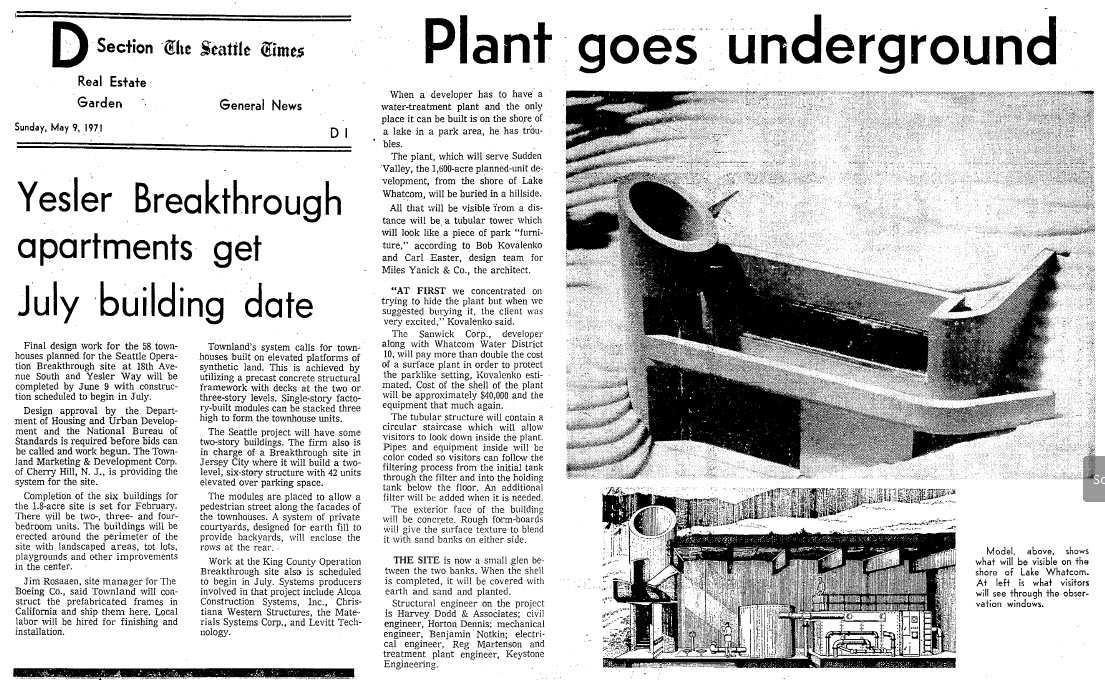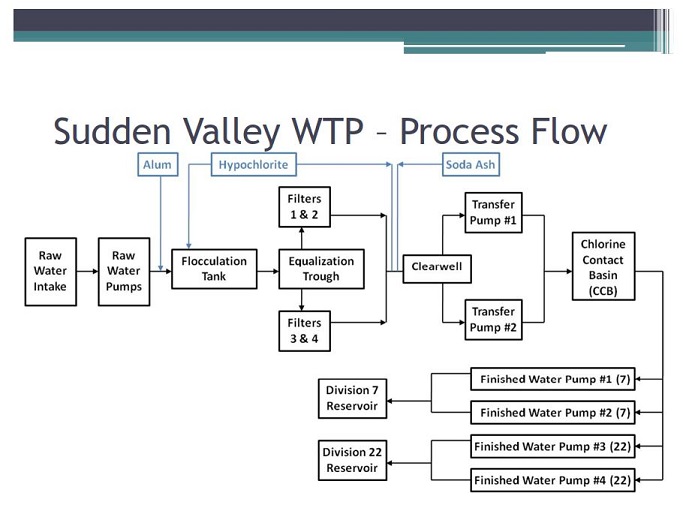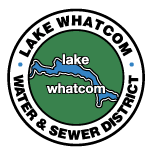Sudden Valley Water Treatment Plant Facility Improvement Plan
Plant History

The Sudden Valley Water Treatment Plant was constructed by the developer of the Sudden Valley residential planned unit development in the early 1970s. Though its final construction varied from the conceptual design that was featured in a Seattle Times article in May of 1971, the plant was constructed into a hillside in what is now the Sudden Valley Community Association’s Morning Beach Park to limit its aesthetic impact on the planned park.
In 1977, Whatcom County Water District No. 10 (now the Lake Whatcom Water and Sewer District) assumed ownership of the plant, as well as the entire water conveyance, storage, and distribution system that had been constructed to serve the Sudden Valley community.
To meet U.S. Environmental Protection Agency (EPA) Surface Water Treatment Rules and increased future demand from new residences, the District completed a comprehensive upgrade and expansion of the plant in 1992 to its current operating treatment capacity of two (2) million gallons per day (mgd). While most of the 1992 upgrades were completed within the footprint of the original (main) building, the expansion also included the construction of the adjacent finished water pump building and the chlorine contact reservoir.
 In 1993, the Sudden Valley Community Association began participating in an initiative to reduce the density of the development at full buildout by approximately 30 percent. Through lot acquisition and conversion to open space, and allowing lot consolidation, approximately 1,400 developable lots were ultimately removed from the potential for development as single family residential homes. This created plant capacity that enabled the District to construct a water main in 2004 to connect the Sudden Valley water system with the District’s Geneva water distribution system, which was previously served by water purchased from the City of Bellingham.
In 1993, the Sudden Valley Community Association began participating in an initiative to reduce the density of the development at full buildout by approximately 30 percent. Through lot acquisition and conversion to open space, and allowing lot consolidation, approximately 1,400 developable lots were ultimately removed from the potential for development as single family residential homes. This created plant capacity that enabled the District to construct a water main in 2004 to connect the Sudden Valley water system with the District’s Geneva water distribution system, which was previously served by water purchased from the City of Bellingham.
The 2004 connection allowed for the plant to serve the entirety of the District’s water customers located on the south shore of Lake Whatcom, which is regulated by the Washington State Department of Health as a Group A water system referred to as the South Shore Water System (DOH Identification No. 95910). The District also operates two smaller Group A water systems located on the north shore of Lake Whatcom (Eagleridge-DOH No. 08118 and Agate Heights-DOH No. 52957).
Plant Process Summary

The Sudden Valley Water Treatment Plant is a rapid rate direct filtration plant that uses chlorine gas for disinfection. Water is drawn from Basin No. 3 of Lake Whatcom at a depth of approximately 70 feet from a location off of Morning Beach. Raw water enters the plant through intake pumps and flows into a 9,000 gallon flocculation tank, which provides initial treatment to increase particle size for more efficient removal by the filter media.
Water is then directed to four filter units, where it is treated by gravity flow through filter media consisting of anthracite, silica sand, garnet, and gravel support layers, injected with chlorine (for disinfection), and then conveyed to a clear well located beneath the plant.
The water is then pumped to the 225,000 gallon chlorine contact reservoir located adjacent to the main plant building to allow for sufficient contact time with the chlorine disinfectant before being conveyed throughout the distribution system by pumps located in the adjacent finished water pump building.
Plant Awards
The District takes seriously its obligations to provide uninterrupted service of safe, clean drinking water to its customers. This diligence is evidenced by its receipt of the 20-Year Award in 2021 for 20 consecutive years of meeting Washington State Department of Health’s Treatment Optimization Program (TOP) regulations. The District is one of only four of the 59 filtration treatment plants operating in Washington State to have received the 20-year Award.
Project Summary (Project No. C1913)
Recognizing that nearly 30 years had passed since the last major plant upgrade (1992) relative to the typical service life expectancies of much of the plant equipment, the District Board of Commissioners included funding in the District’s 2019 Budget to initiate the development of a 20 Year Facility Plan. The goal of this plan is to assess the current plant condition and then proactively develop a phased approach over the 20-year planning horizon to cost effectively complete plant improvements which will serve the District for the next several decades. Project objectives included:
- Identify and document specific operational, maintenance, renewal, and replacement needs for the water treatment plant (including, but not limited to: concrete building structure, underground vaults, motors, pumps, piping, valves, electrical, controls, heating and ventilation, tanks, chemical handling, and laboratory) for the 20-year planning horizon
- Utilize modern systems and controls to optimize the performance of the water treatment plant
- Increase treatment plant automations that can lower operating costs
- Optimize water quality at lower operational costs
- Prioritize the improvements
- Analyze the physical space requirements for the identified improvements
- Develop several conceptual plans that accommodate all system components (including determination if additional space will be required)
- Sequence the improvements into logical phases such that each phase builds upon prior completed phases
- Develop conceptual cost estimates for each phase along with a written narrative that describes the scope of work and assumptions
- Develop a conceptual timeline for design, permitting, and construction of each phase over the planning horizon
- Increase plant reliability
- Comply with the EPA’s Surface Water Treatment Rules
- Prioritize and program improvements, studies, and plans to comply with America’s Water Infrastructure Act of 2018 (AWIA)
Following review of project proposals from qualified engineering firms, the District selected Gray & Osborne Inc. (G&O) to complete the master plan.
Phase 1—Condition Assessment
Under the initial phase of the project, G&O performed a condition assessment of the existing treatment plant system. The purpose of the assessment was to investigate the integrity of the existing plant facilities from a structural, electrical, mechanical, architectural, and process perspective to guide decisions on use and/or modification of the plant. The effort culminated in the issuance of the Sudden Valley Water Treatment Plant Assessment Report in July 2020. In summary, the report identified several items for improvement, but did not find any significant issues that would prevent ongoing successful operation. The report did provide prioritized recommendations for potential improvements to increase operational efficiencies and/or proactively plan for component replacement in advance of failure. The Condition Assessment Report is available in the Project Library below.
Phase 2—Alternatives Analysis
Following completion of the condition assessment, G&O embarked on performance of an alternatives analysis to help the District select and prioritize specific near- and long-term improvements to the treatment equipment and processes. The work was broken down into major systems, with alternatives developed specific to each system and documented in a technical memorandum. The major systems included:
- Pump Performance Test
- Chemical Systems Analysis
- Disinfection Systems Analysis
- Backwash Systems Analysis
- Filtration Systems Analysis
- Tier 2/3 Seismic and Structural Analysis
- Structural/ Architectural Workspace Analysis
- National Association of Corrosion Engineers (NACE) III Coating Inspection
As each system was analyzed, presented, and discussed over multiple public Board meetings, six (6) long-term goals were developed against which proposed plant improvement options/configurations will be considered:
- G1—Maintain exceptional water quality performance record
- G2—Accommodate immediate need for additional space and separation of chemicals/electrical equipment
- G3—Provide adequate equipment and process redundancy
- G4—Improve access and flexibility for equipment repair/rehabilitation and/or future expansion
- G5—Provide capacity for full buildout flow (2 mgd/1,400 gpm)
- G6—Provide treatment equipment for 30-50 year operational timeframe
Technical memoranda documenting each system’s alternatives analysis are available in the Project Library below.
Phase 3—Alternatives Analysis Report
The Alternatives Analysis Report, which holistically considered all system alternatives and associated water utility rate impacts to determine the most economical and efficient means of phasing needed improvement over the 20-year planning horizon, was completed in November 2022. Click here to view the final report.
Project Schedule
Master Plan Schedule
- Phase 1—Condition Assessment—Complete (January-July 2020)
- Phase 2—Alternatives Analysis—Complete (August 2020-May 2021)
- Phase 3—Alternatives Analysis Report—Complete (November 2022)
Plant Improvement Schedule
The improvement schedule that aligns with the Alternatives Analysis Report recommendations will be incorporated into the Water System Six-year Capital Improvement Program, as well as consideration of sequencing of improvements and available funding over the 20-year planning horizon.
Project Cost
Master Plan Cost
The total project cost was $130,000.
Plant Improvement Cost
Following careful consideration of necessary improvements to the treatment plant relative to rate revenues necessary to finance those improvements, the Board of Commissioners selected a phased approach over the 20-year planning horizon with a total estimated cost of $6.5 million.
Project Contact
Bill Hunter, PE
District Engineer
360.734.9224
bill.hunter@lwwsd.org
Project Library
Agenda Bills
- 2019.11.13 SVWTP Facility Plan Project Award
- 2020.06.24 SVWTP Condition Assessment Presentation
- 2020.07.08 SVWTP Alternatives Analysis Project Award
- 2020.09.30 SVWTP Pump Performance Test and NACE III Coating Inspection Presentation
- 2020.11.25 SVWTP Chemical Systems Analysis and Tier 2/3 Seismic and Structural Analysis Presentation
- 2020.12.30 SVWTP Filtration System Analysis Presentation
- 2021.02.10 SVWTP Disinfection System Analysis Presentation
- 2021.03.10 SVWTP Backwash System Analysis Presentation
- 2021.04.14 SVWTP Structural/Architectural Workspace Analysis Presentation
- 2021.05.26 SVWTP Master Plan Stakeholder Engagement Process Discussion
- 2021.08.11 SVWTP Presentation of Preferred Configuration Work Session Packet
Board Presentations
- 2020.06.24 SVWTP Condition Assessment Presentation
- 2020.09.30 SVWTP Pump Performance Test and NACE III Coating Inspection Presentation
- 2020.11.25 SVWTP Chemical Systems Analysis and Tier 2/3 Seismic and Structural Analysis Presentation
- 2020.12.30 SVWTP Filtration System Analysis Presentation
- 2021.02.10 SVWTP Disinfection System Analysis Presentation
- 2021.03.10 SVWTP Backwash System Analysis Presentation
- 2021.04.14 SVWTP Structural/Architectural Workspace Analysis Presentation
- 2021.08.11 SVWTP Presentation Risk Analysis & Alternatives
Reports/Memoranda
- 2020.07 Sudden Valley Water Treatment Plant Assessment Report
- 2020.09.23 Tech Memo 20434-1 – Sudden Valley WTP Pump Performance Testing
- 2020.09.23 Tech Memo 20434-2 – Sudden Valley WTP Chlorine Contact Basin Coating Assessment
- 2020.11.18 Tech Memo 20434-3 – Sudden Valley WTP Tier 2-Tier 3 Seismic Evaluation
- 2020.11.18 Tech Memo 20434-4 – Sudden Valley WTP Chemical Systems Analysis
- 2020.12.07 Tech Memo 20434-5 – Sudden Valley WTP Filtration System Analysis
- 2021.01.15 Tech Memo 20434-6 – Sudden Valley WTP Disinfection System Analysis
- 2021.02.25 Tech Memo 20434-7 – Sudden Valley WTP Backwash Systems Analysis
- 2021.03.31 Tech Memo 20434-8 – Sudden Valley WTP Structural and Architectural System Analysis
- Tech Memo 20434-9 – Sudden Valley WTP Equipment Risk Assessment
- 2022.11.22 Alternatives Analysis – Final Report
